Strategic Management Report: Lidl's Growth in Asian Market (India)
VerifiedAdded on 2023/01/19
|13
|4492
|49
Report
AI Summary
This strategic management report analyzes Lidl's potential for expansion into the Indian market. It begins with an executive summary and table of contents, followed by an introduction to Lidl, including its vision, mission, objectives, and a SWOT analysis. The report then delves into external analysis using the PESTLE framework, examining political, economic, social, technological, legal, and environmental factors impacting Lidl's operations in India, along with opportunities and threats. Porter's Five Forces model is used to assess the competitive landscape. An internal analysis is performed, followed by strategic options and direction. The report concludes with recommendations for Lidl to achieve a competitive advantage in the Indian market, considering both internal capabilities and external factors such as taxation, competition, and consumer behavior. The report is structured to provide a comprehensive understanding of the strategic challenges and opportunities facing Lidl in the Indian market, with the goal of formulating effective strategies for sustainable growth.

Strategic
Management
Management
Paraphrase This Document
Need a fresh take? Get an instant paraphrase of this document with our AI Paraphraser
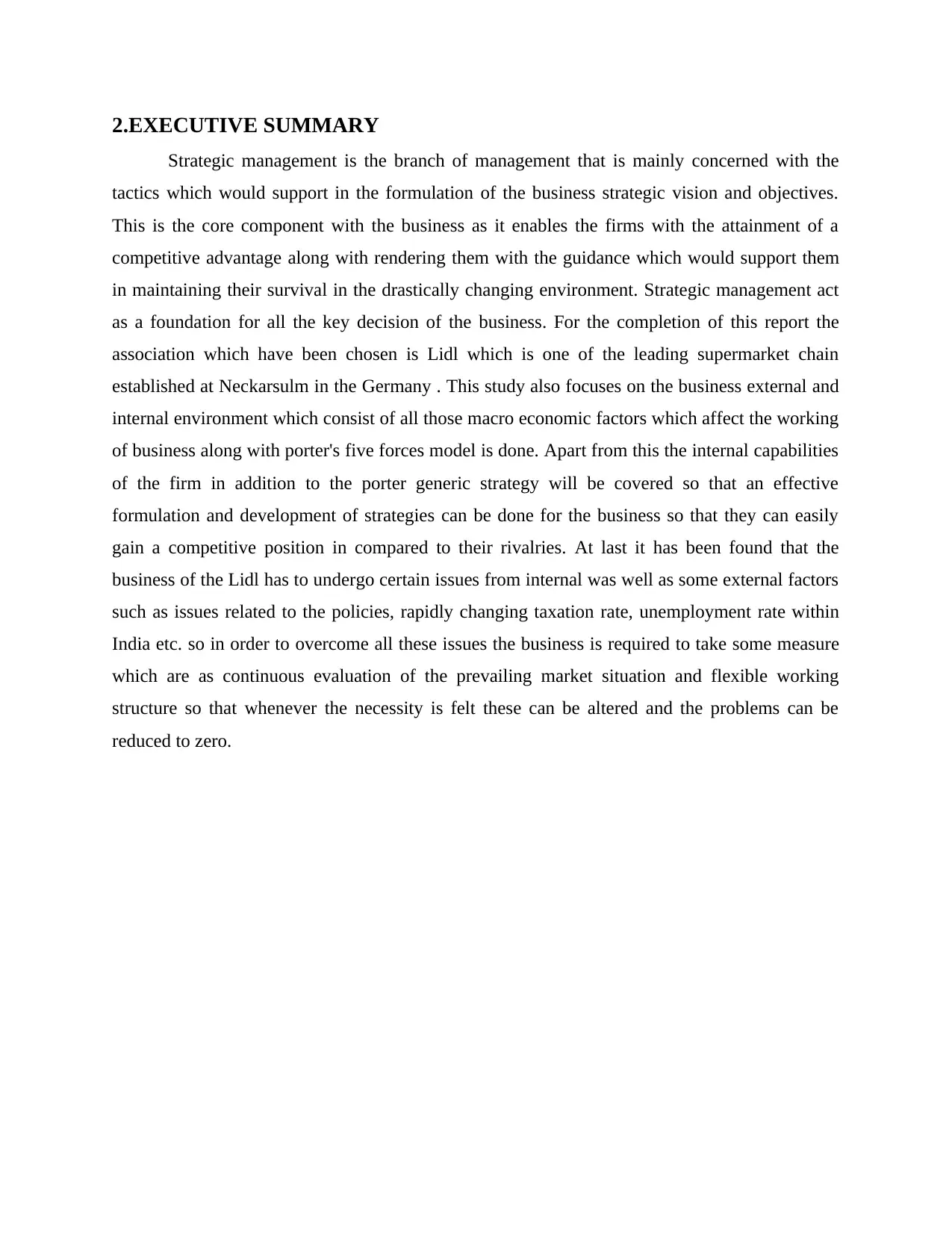
2.EXECUTIVE SUMMARY
Strategic management is the branch of management that is mainly concerned with the
tactics which would support in the formulation of the business strategic vision and objectives.
This is the core component with the business as it enables the firms with the attainment of a
competitive advantage along with rendering them with the guidance which would support them
in maintaining their survival in the drastically changing environment. Strategic management act
as a foundation for all the key decision of the business. For the completion of this report the
association which have been chosen is Lidl which is one of the leading supermarket chain
established at Neckarsulm in the Germany . This study also focuses on the business external and
internal environment which consist of all those macro economic factors which affect the working
of business along with porter's five forces model is done. Apart from this the internal capabilities
of the firm in addition to the porter generic strategy will be covered so that an effective
formulation and development of strategies can be done for the business so that they can easily
gain a competitive position in compared to their rivalries. At last it has been found that the
business of the Lidl has to undergo certain issues from internal was well as some external factors
such as issues related to the policies, rapidly changing taxation rate, unemployment rate within
India etc. so in order to overcome all these issues the business is required to take some measure
which are as continuous evaluation of the prevailing market situation and flexible working
structure so that whenever the necessity is felt these can be altered and the problems can be
reduced to zero.
Strategic management is the branch of management that is mainly concerned with the
tactics which would support in the formulation of the business strategic vision and objectives.
This is the core component with the business as it enables the firms with the attainment of a
competitive advantage along with rendering them with the guidance which would support them
in maintaining their survival in the drastically changing environment. Strategic management act
as a foundation for all the key decision of the business. For the completion of this report the
association which have been chosen is Lidl which is one of the leading supermarket chain
established at Neckarsulm in the Germany . This study also focuses on the business external and
internal environment which consist of all those macro economic factors which affect the working
of business along with porter's five forces model is done. Apart from this the internal capabilities
of the firm in addition to the porter generic strategy will be covered so that an effective
formulation and development of strategies can be done for the business so that they can easily
gain a competitive position in compared to their rivalries. At last it has been found that the
business of the Lidl has to undergo certain issues from internal was well as some external factors
such as issues related to the policies, rapidly changing taxation rate, unemployment rate within
India etc. so in order to overcome all these issues the business is required to take some measure
which are as continuous evaluation of the prevailing market situation and flexible working
structure so that whenever the necessity is felt these can be altered and the problems can be
reduced to zero.
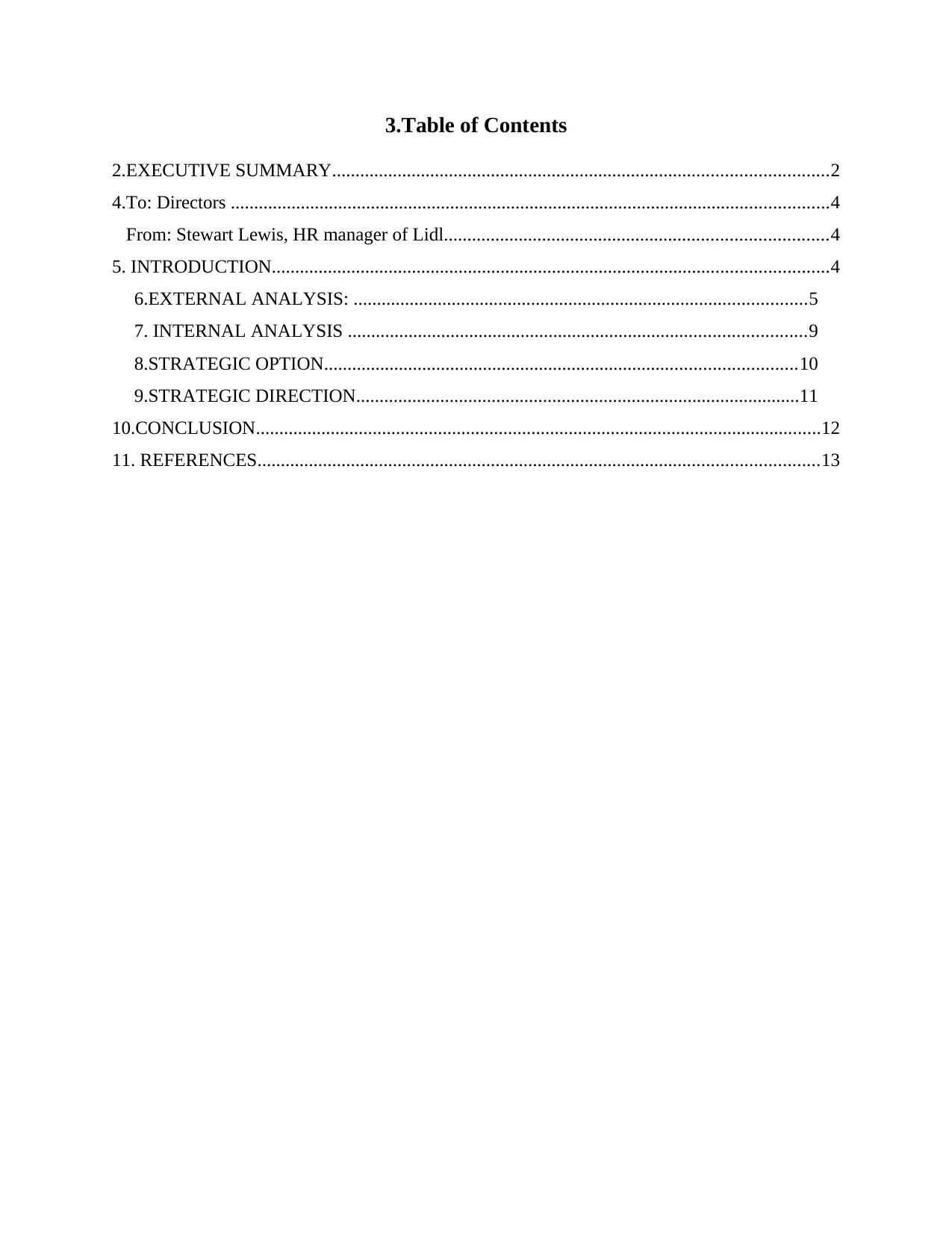
3.Table of Contents
2.EXECUTIVE SUMMARY..........................................................................................................2
4.To: Directors ................................................................................................................................4
From: Stewart Lewis, HR manager of Lidl..................................................................................4
5. INTRODUCTION.......................................................................................................................4
6.EXTERNAL ANALYSIS: .................................................................................................5
7. INTERNAL ANALYSIS ..................................................................................................9
8.STRATEGIC OPTION.....................................................................................................10
9.STRATEGIC DIRECTION...............................................................................................11
10.CONCLUSION.........................................................................................................................12
11. REFERENCES........................................................................................................................13
2.EXECUTIVE SUMMARY..........................................................................................................2
4.To: Directors ................................................................................................................................4
From: Stewart Lewis, HR manager of Lidl..................................................................................4
5. INTRODUCTION.......................................................................................................................4
6.EXTERNAL ANALYSIS: .................................................................................................5
7. INTERNAL ANALYSIS ..................................................................................................9
8.STRATEGIC OPTION.....................................................................................................10
9.STRATEGIC DIRECTION...............................................................................................11
10.CONCLUSION.........................................................................................................................12
11. REFERENCES........................................................................................................................13
⊘ This is a preview!⊘
Do you want full access?
Subscribe today to unlock all pages.

Trusted by 1+ million students worldwide
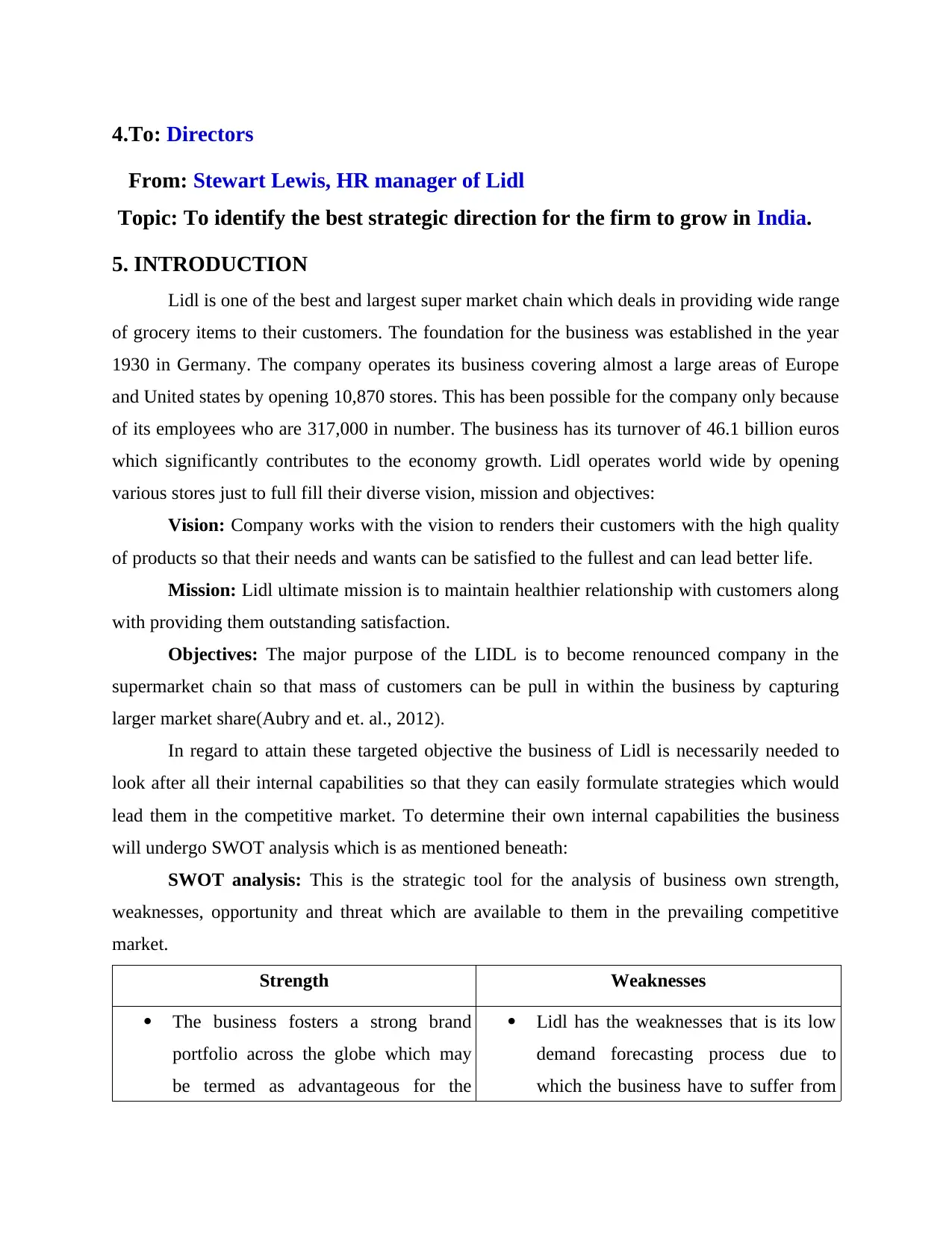
4.To: Directors
From: Stewart Lewis, HR manager of Lidl
Topic: To identify the best strategic direction for the firm to grow in India.
5. INTRODUCTION
Lidl is one of the best and largest super market chain which deals in providing wide range
of grocery items to their customers. The foundation for the business was established in the year
1930 in Germany. The company operates its business covering almost a large areas of Europe
and United states by opening 10,870 stores. This has been possible for the company only because
of its employees who are 317,000 in number. The business has its turnover of 46.1 billion euros
which significantly contributes to the economy growth. Lidl operates world wide by opening
various stores just to full fill their diverse vision, mission and objectives:
Vision: Company works with the vision to renders their customers with the high quality
of products so that their needs and wants can be satisfied to the fullest and can lead better life.
Mission: Lidl ultimate mission is to maintain healthier relationship with customers along
with providing them outstanding satisfaction.
Objectives: The major purpose of the LIDL is to become renounced company in the
supermarket chain so that mass of customers can be pull in within the business by capturing
larger market share(Aubry and et. al., 2012).
In regard to attain these targeted objective the business of Lidl is necessarily needed to
look after all their internal capabilities so that they can easily formulate strategies which would
lead them in the competitive market. To determine their own internal capabilities the business
will undergo SWOT analysis which is as mentioned beneath:
SWOT analysis: This is the strategic tool for the analysis of business own strength,
weaknesses, opportunity and threat which are available to them in the prevailing competitive
market.
Strength Weaknesses
The business fosters a strong brand
portfolio across the globe which may
be termed as advantageous for the
Lidl has the weaknesses that is its low
demand forecasting process due to
which the business have to suffer from
From: Stewart Lewis, HR manager of Lidl
Topic: To identify the best strategic direction for the firm to grow in India.
5. INTRODUCTION
Lidl is one of the best and largest super market chain which deals in providing wide range
of grocery items to their customers. The foundation for the business was established in the year
1930 in Germany. The company operates its business covering almost a large areas of Europe
and United states by opening 10,870 stores. This has been possible for the company only because
of its employees who are 317,000 in number. The business has its turnover of 46.1 billion euros
which significantly contributes to the economy growth. Lidl operates world wide by opening
various stores just to full fill their diverse vision, mission and objectives:
Vision: Company works with the vision to renders their customers with the high quality
of products so that their needs and wants can be satisfied to the fullest and can lead better life.
Mission: Lidl ultimate mission is to maintain healthier relationship with customers along
with providing them outstanding satisfaction.
Objectives: The major purpose of the LIDL is to become renounced company in the
supermarket chain so that mass of customers can be pull in within the business by capturing
larger market share(Aubry and et. al., 2012).
In regard to attain these targeted objective the business of Lidl is necessarily needed to
look after all their internal capabilities so that they can easily formulate strategies which would
lead them in the competitive market. To determine their own internal capabilities the business
will undergo SWOT analysis which is as mentioned beneath:
SWOT analysis: This is the strategic tool for the analysis of business own strength,
weaknesses, opportunity and threat which are available to them in the prevailing competitive
market.
Strength Weaknesses
The business fosters a strong brand
portfolio across the globe which may
be termed as advantageous for the
Lidl has the weaknesses that is its low
demand forecasting process due to
which the business have to suffer from
Paraphrase This Document
Need a fresh take? Get an instant paraphrase of this document with our AI Paraphraser
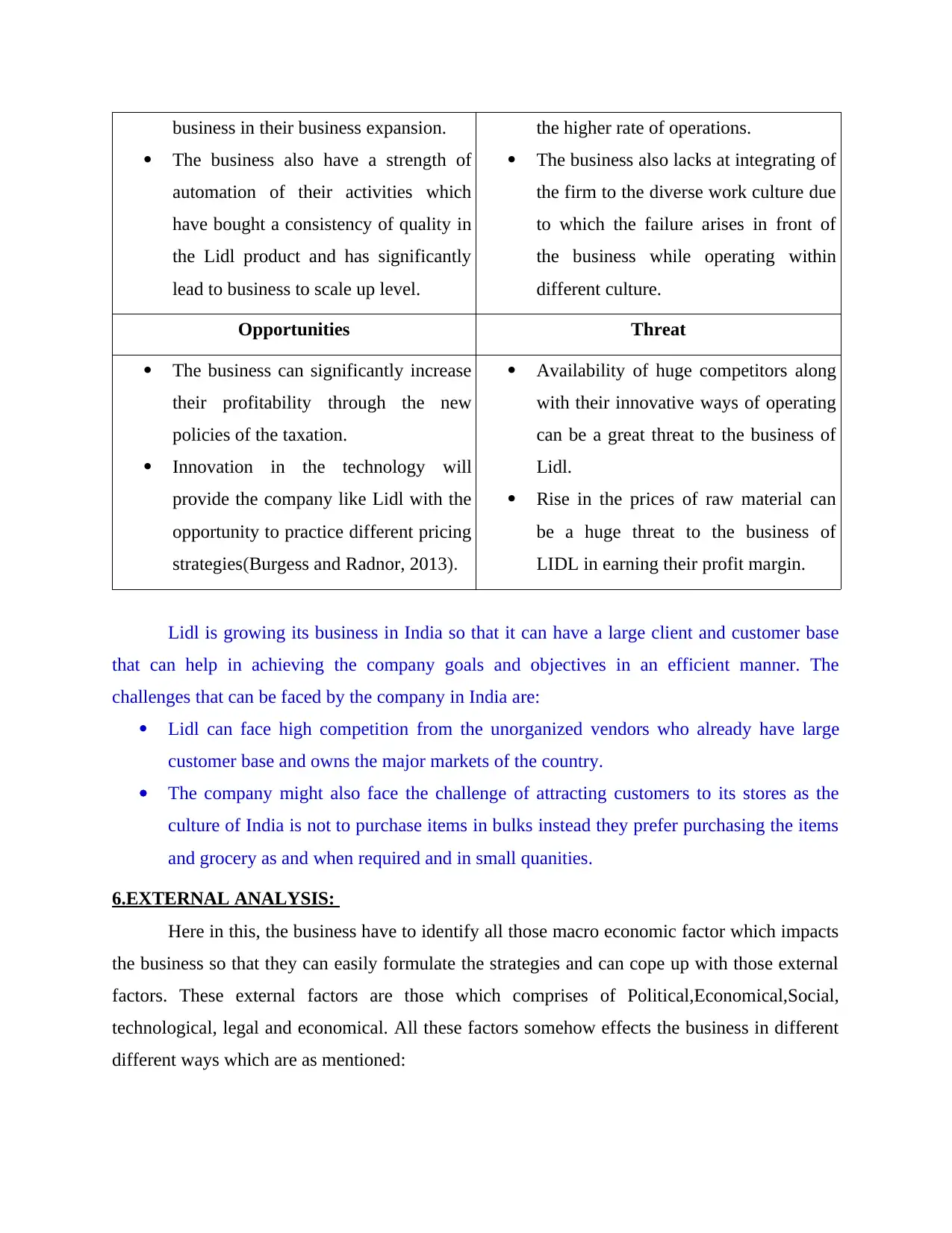
business in their business expansion.
The business also have a strength of
automation of their activities which
have bought a consistency of quality in
the Lidl product and has significantly
lead to business to scale up level.
the higher rate of operations.
The business also lacks at integrating of
the firm to the diverse work culture due
to which the failure arises in front of
the business while operating within
different culture.
Opportunities Threat
The business can significantly increase
their profitability through the new
policies of the taxation.
Innovation in the technology will
provide the company like Lidl with the
opportunity to practice different pricing
strategies(Burgess and Radnor, 2013).
Availability of huge competitors along
with their innovative ways of operating
can be a great threat to the business of
Lidl.
Rise in the prices of raw material can
be a huge threat to the business of
LIDL in earning their profit margin.
Lidl is growing its business in India so that it can have a large client and customer base
that can help in achieving the company goals and objectives in an efficient manner. The
challenges that can be faced by the company in India are:
Lidl can face high competition from the unorganized vendors who already have large
customer base and owns the major markets of the country.
The company might also face the challenge of attracting customers to its stores as the
culture of India is not to purchase items in bulks instead they prefer purchasing the items
and grocery as and when required and in small quanities.
6.EXTERNAL ANALYSIS:
Here in this, the business have to identify all those macro economic factor which impacts
the business so that they can easily formulate the strategies and can cope up with those external
factors. These external factors are those which comprises of Political,Economical,Social,
technological, legal and economical. All these factors somehow effects the business in different
different ways which are as mentioned:
The business also have a strength of
automation of their activities which
have bought a consistency of quality in
the Lidl product and has significantly
lead to business to scale up level.
the higher rate of operations.
The business also lacks at integrating of
the firm to the diverse work culture due
to which the failure arises in front of
the business while operating within
different culture.
Opportunities Threat
The business can significantly increase
their profitability through the new
policies of the taxation.
Innovation in the technology will
provide the company like Lidl with the
opportunity to practice different pricing
strategies(Burgess and Radnor, 2013).
Availability of huge competitors along
with their innovative ways of operating
can be a great threat to the business of
Lidl.
Rise in the prices of raw material can
be a huge threat to the business of
LIDL in earning their profit margin.
Lidl is growing its business in India so that it can have a large client and customer base
that can help in achieving the company goals and objectives in an efficient manner. The
challenges that can be faced by the company in India are:
Lidl can face high competition from the unorganized vendors who already have large
customer base and owns the major markets of the country.
The company might also face the challenge of attracting customers to its stores as the
culture of India is not to purchase items in bulks instead they prefer purchasing the items
and grocery as and when required and in small quanities.
6.EXTERNAL ANALYSIS:
Here in this, the business have to identify all those macro economic factor which impacts
the business so that they can easily formulate the strategies and can cope up with those external
factors. These external factors are those which comprises of Political,Economical,Social,
technological, legal and economical. All these factors somehow effects the business in different
different ways which are as mentioned:
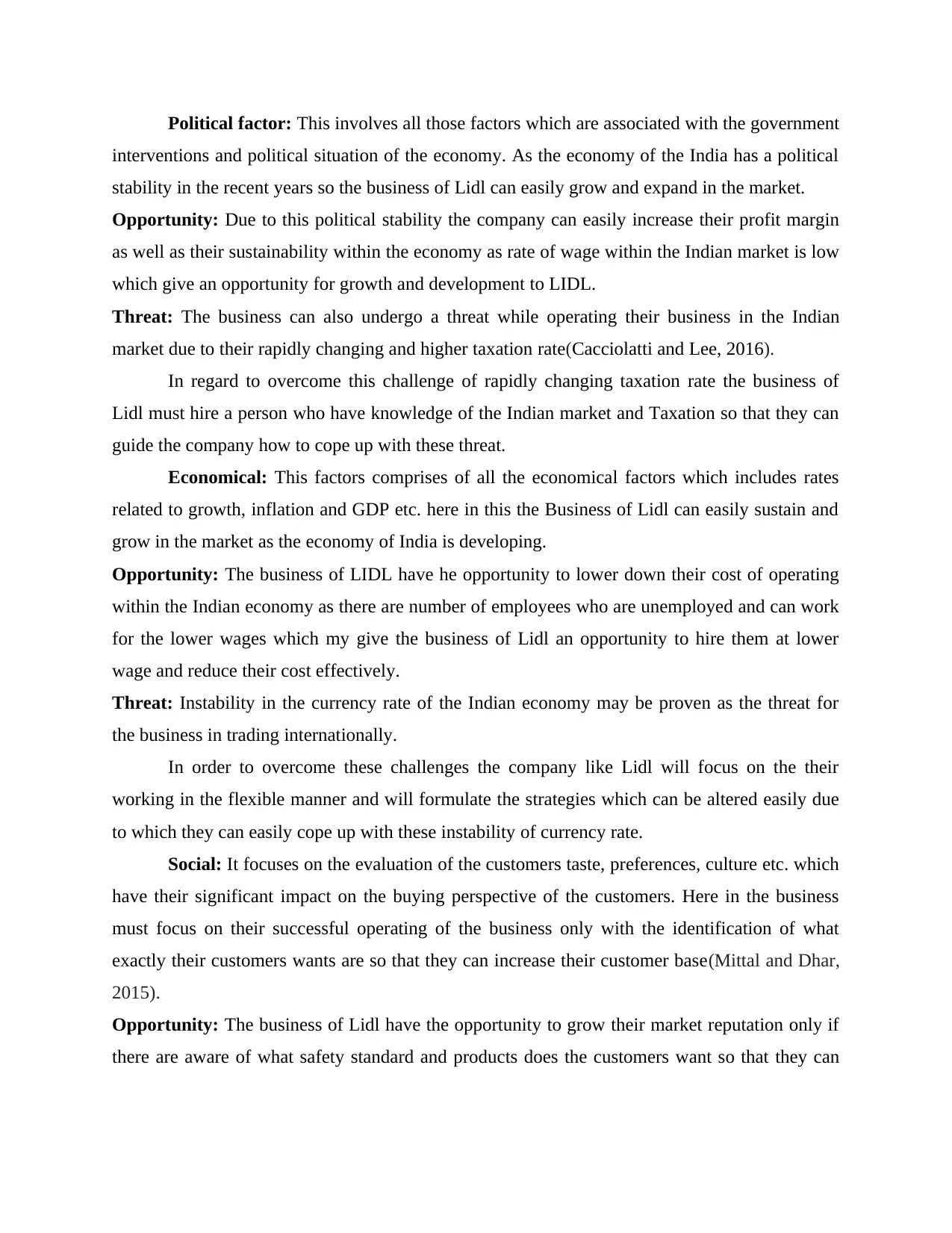
Political factor: This involves all those factors which are associated with the government
interventions and political situation of the economy. As the economy of the India has a political
stability in the recent years so the business of Lidl can easily grow and expand in the market.
Opportunity: Due to this political stability the company can easily increase their profit margin
as well as their sustainability within the economy as rate of wage within the Indian market is low
which give an opportunity for growth and development to LIDL.
Threat: The business can also undergo a threat while operating their business in the Indian
market due to their rapidly changing and higher taxation rate(Cacciolatti and Lee, 2016).
In regard to overcome this challenge of rapidly changing taxation rate the business of
Lidl must hire a person who have knowledge of the Indian market and Taxation so that they can
guide the company how to cope up with these threat.
Economical: This factors comprises of all the economical factors which includes rates
related to growth, inflation and GDP etc. here in this the Business of Lidl can easily sustain and
grow in the market as the economy of India is developing.
Opportunity: The business of LIDL have he opportunity to lower down their cost of operating
within the Indian economy as there are number of employees who are unemployed and can work
for the lower wages which my give the business of Lidl an opportunity to hire them at lower
wage and reduce their cost effectively.
Threat: Instability in the currency rate of the Indian economy may be proven as the threat for
the business in trading internationally.
In order to overcome these challenges the company like Lidl will focus on the their
working in the flexible manner and will formulate the strategies which can be altered easily due
to which they can easily cope up with these instability of currency rate.
Social: It focuses on the evaluation of the customers taste, preferences, culture etc. which
have their significant impact on the buying perspective of the customers. Here in the business
must focus on their successful operating of the business only with the identification of what
exactly their customers wants are so that they can increase their customer base(Mittal and Dhar,
2015).
Opportunity: The business of Lidl have the opportunity to grow their market reputation only if
there are aware of what safety standard and products does the customers want so that they can
interventions and political situation of the economy. As the economy of the India has a political
stability in the recent years so the business of Lidl can easily grow and expand in the market.
Opportunity: Due to this political stability the company can easily increase their profit margin
as well as their sustainability within the economy as rate of wage within the Indian market is low
which give an opportunity for growth and development to LIDL.
Threat: The business can also undergo a threat while operating their business in the Indian
market due to their rapidly changing and higher taxation rate(Cacciolatti and Lee, 2016).
In regard to overcome this challenge of rapidly changing taxation rate the business of
Lidl must hire a person who have knowledge of the Indian market and Taxation so that they can
guide the company how to cope up with these threat.
Economical: This factors comprises of all the economical factors which includes rates
related to growth, inflation and GDP etc. here in this the Business of Lidl can easily sustain and
grow in the market as the economy of India is developing.
Opportunity: The business of LIDL have he opportunity to lower down their cost of operating
within the Indian economy as there are number of employees who are unemployed and can work
for the lower wages which my give the business of Lidl an opportunity to hire them at lower
wage and reduce their cost effectively.
Threat: Instability in the currency rate of the Indian economy may be proven as the threat for
the business in trading internationally.
In order to overcome these challenges the company like Lidl will focus on the their
working in the flexible manner and will formulate the strategies which can be altered easily due
to which they can easily cope up with these instability of currency rate.
Social: It focuses on the evaluation of the customers taste, preferences, culture etc. which
have their significant impact on the buying perspective of the customers. Here in the business
must focus on their successful operating of the business only with the identification of what
exactly their customers wants are so that they can increase their customer base(Mittal and Dhar,
2015).
Opportunity: The business of Lidl have the opportunity to grow their market reputation only if
there are aware of what safety standard and products does the customers want so that they can
⊘ This is a preview!⊘
Do you want full access?
Subscribe today to unlock all pages.

Trusted by 1+ million students worldwide
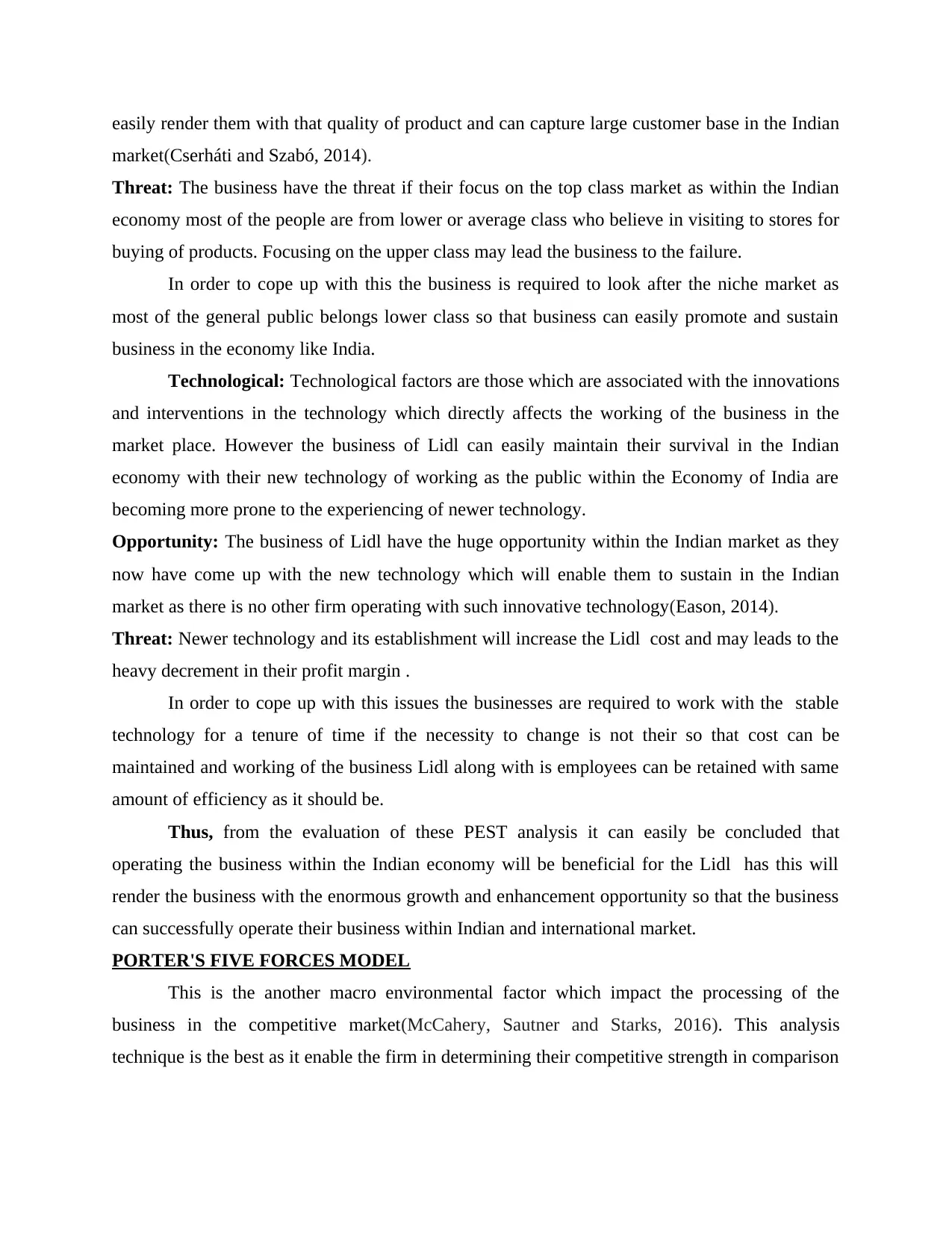
easily render them with that quality of product and can capture large customer base in the Indian
market(Cserháti and Szabó, 2014).
Threat: The business have the threat if their focus on the top class market as within the Indian
economy most of the people are from lower or average class who believe in visiting to stores for
buying of products. Focusing on the upper class may lead the business to the failure.
In order to cope up with this the business is required to look after the niche market as
most of the general public belongs lower class so that business can easily promote and sustain
business in the economy like India.
Technological: Technological factors are those which are associated with the innovations
and interventions in the technology which directly affects the working of the business in the
market place. However the business of Lidl can easily maintain their survival in the Indian
economy with their new technology of working as the public within the Economy of India are
becoming more prone to the experiencing of newer technology.
Opportunity: The business of Lidl have the huge opportunity within the Indian market as they
now have come up with the new technology which will enable them to sustain in the Indian
market as there is no other firm operating with such innovative technology(Eason, 2014).
Threat: Newer technology and its establishment will increase the Lidl cost and may leads to the
heavy decrement in their profit margin .
In order to cope up with this issues the businesses are required to work with the stable
technology for a tenure of time if the necessity to change is not their so that cost can be
maintained and working of the business Lidl along with is employees can be retained with same
amount of efficiency as it should be.
Thus, from the evaluation of these PEST analysis it can easily be concluded that
operating the business within the Indian economy will be beneficial for the Lidl has this will
render the business with the enormous growth and enhancement opportunity so that the business
can successfully operate their business within Indian and international market.
PORTER'S FIVE FORCES MODEL
This is the another macro environmental factor which impact the processing of the
business in the competitive market(McCahery, Sautner and Starks, 2016). This analysis
technique is the best as it enable the firm in determining their competitive strength in comparison
market(Cserháti and Szabó, 2014).
Threat: The business have the threat if their focus on the top class market as within the Indian
economy most of the people are from lower or average class who believe in visiting to stores for
buying of products. Focusing on the upper class may lead the business to the failure.
In order to cope up with this the business is required to look after the niche market as
most of the general public belongs lower class so that business can easily promote and sustain
business in the economy like India.
Technological: Technological factors are those which are associated with the innovations
and interventions in the technology which directly affects the working of the business in the
market place. However the business of Lidl can easily maintain their survival in the Indian
economy with their new technology of working as the public within the Economy of India are
becoming more prone to the experiencing of newer technology.
Opportunity: The business of Lidl have the huge opportunity within the Indian market as they
now have come up with the new technology which will enable them to sustain in the Indian
market as there is no other firm operating with such innovative technology(Eason, 2014).
Threat: Newer technology and its establishment will increase the Lidl cost and may leads to the
heavy decrement in their profit margin .
In order to cope up with this issues the businesses are required to work with the stable
technology for a tenure of time if the necessity to change is not their so that cost can be
maintained and working of the business Lidl along with is employees can be retained with same
amount of efficiency as it should be.
Thus, from the evaluation of these PEST analysis it can easily be concluded that
operating the business within the Indian economy will be beneficial for the Lidl has this will
render the business with the enormous growth and enhancement opportunity so that the business
can successfully operate their business within Indian and international market.
PORTER'S FIVE FORCES MODEL
This is the another macro environmental factor which impact the processing of the
business in the competitive market(McCahery, Sautner and Starks, 2016). This analysis
technique is the best as it enable the firm in determining their competitive strength in comparison
Paraphrase This Document
Need a fresh take? Get an instant paraphrase of this document with our AI Paraphraser
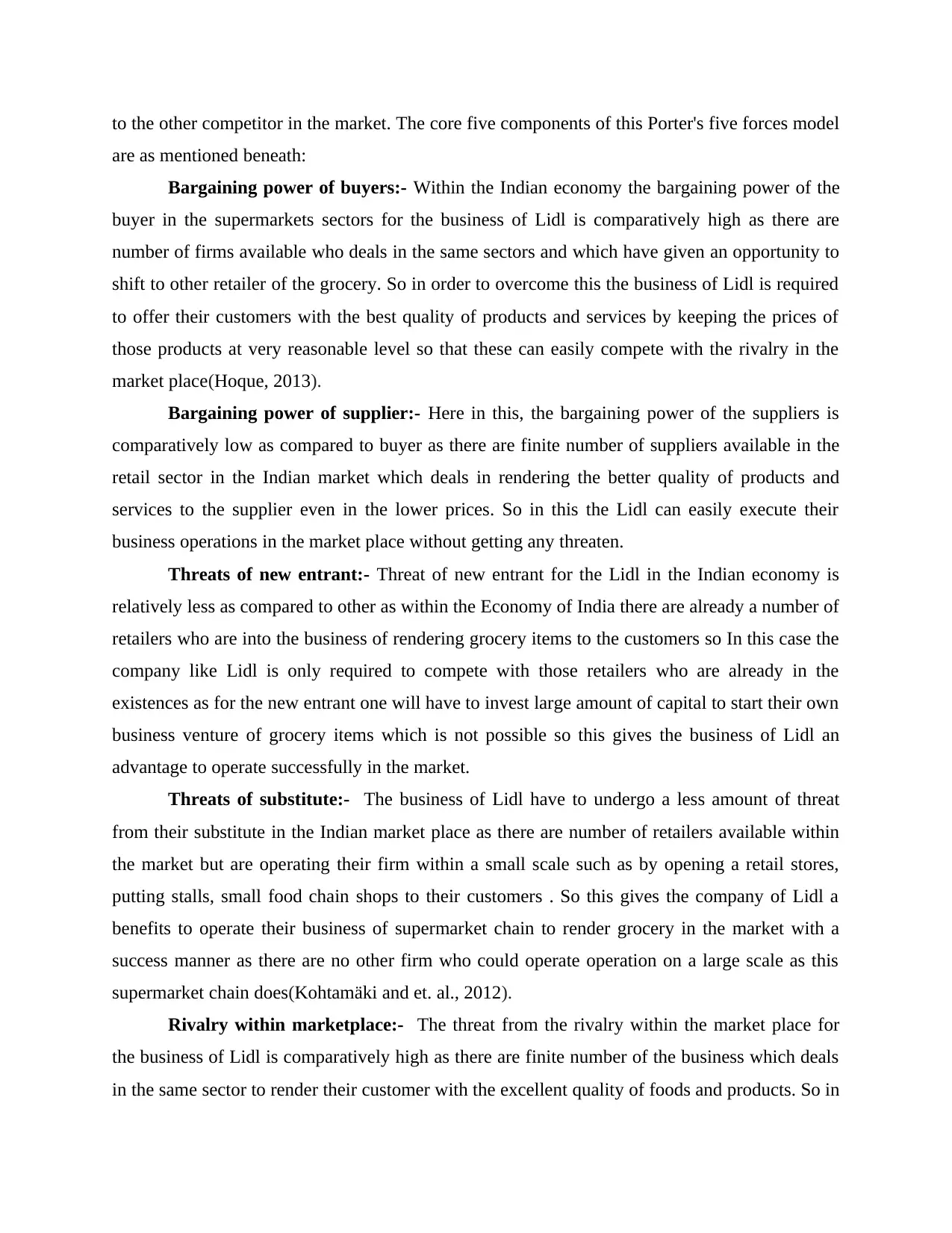
to the other competitor in the market. The core five components of this Porter's five forces model
are as mentioned beneath:
Bargaining power of buyers:- Within the Indian economy the bargaining power of the
buyer in the supermarkets sectors for the business of Lidl is comparatively high as there are
number of firms available who deals in the same sectors and which have given an opportunity to
shift to other retailer of the grocery. So in order to overcome this the business of Lidl is required
to offer their customers with the best quality of products and services by keeping the prices of
those products at very reasonable level so that these can easily compete with the rivalry in the
market place(Hoque, 2013).
Bargaining power of supplier:- Here in this, the bargaining power of the suppliers is
comparatively low as compared to buyer as there are finite number of suppliers available in the
retail sector in the Indian market which deals in rendering the better quality of products and
services to the supplier even in the lower prices. So in this the Lidl can easily execute their
business operations in the market place without getting any threaten.
Threats of new entrant:- Threat of new entrant for the Lidl in the Indian economy is
relatively less as compared to other as within the Economy of India there are already a number of
retailers who are into the business of rendering grocery items to the customers so In this case the
company like Lidl is only required to compete with those retailers who are already in the
existences as for the new entrant one will have to invest large amount of capital to start their own
business venture of grocery items which is not possible so this gives the business of Lidl an
advantage to operate successfully in the market.
Threats of substitute:- The business of Lidl have to undergo a less amount of threat
from their substitute in the Indian market place as there are number of retailers available within
the market but are operating their firm within a small scale such as by opening a retail stores,
putting stalls, small food chain shops to their customers . So this gives the company of Lidl a
benefits to operate their business of supermarket chain to render grocery in the market with a
success manner as there are no other firm who could operate operation on a large scale as this
supermarket chain does(Kohtamäki and et. al., 2012).
Rivalry within marketplace:- The threat from the rivalry within the market place for
the business of Lidl is comparatively high as there are finite number of the business which deals
in the same sector to render their customer with the excellent quality of foods and products. So in
are as mentioned beneath:
Bargaining power of buyers:- Within the Indian economy the bargaining power of the
buyer in the supermarkets sectors for the business of Lidl is comparatively high as there are
number of firms available who deals in the same sectors and which have given an opportunity to
shift to other retailer of the grocery. So in order to overcome this the business of Lidl is required
to offer their customers with the best quality of products and services by keeping the prices of
those products at very reasonable level so that these can easily compete with the rivalry in the
market place(Hoque, 2013).
Bargaining power of supplier:- Here in this, the bargaining power of the suppliers is
comparatively low as compared to buyer as there are finite number of suppliers available in the
retail sector in the Indian market which deals in rendering the better quality of products and
services to the supplier even in the lower prices. So in this the Lidl can easily execute their
business operations in the market place without getting any threaten.
Threats of new entrant:- Threat of new entrant for the Lidl in the Indian economy is
relatively less as compared to other as within the Economy of India there are already a number of
retailers who are into the business of rendering grocery items to the customers so In this case the
company like Lidl is only required to compete with those retailers who are already in the
existences as for the new entrant one will have to invest large amount of capital to start their own
business venture of grocery items which is not possible so this gives the business of Lidl an
advantage to operate successfully in the market.
Threats of substitute:- The business of Lidl have to undergo a less amount of threat
from their substitute in the Indian market place as there are number of retailers available within
the market but are operating their firm within a small scale such as by opening a retail stores,
putting stalls, small food chain shops to their customers . So this gives the company of Lidl a
benefits to operate their business of supermarket chain to render grocery in the market with a
success manner as there are no other firm who could operate operation on a large scale as this
supermarket chain does(Kohtamäki and et. al., 2012).
Rivalry within marketplace:- The threat from the rivalry within the market place for
the business of Lidl is comparatively high as there are finite number of the business which deals
in the same sector to render their customer with the excellent quality of foods and products. So in
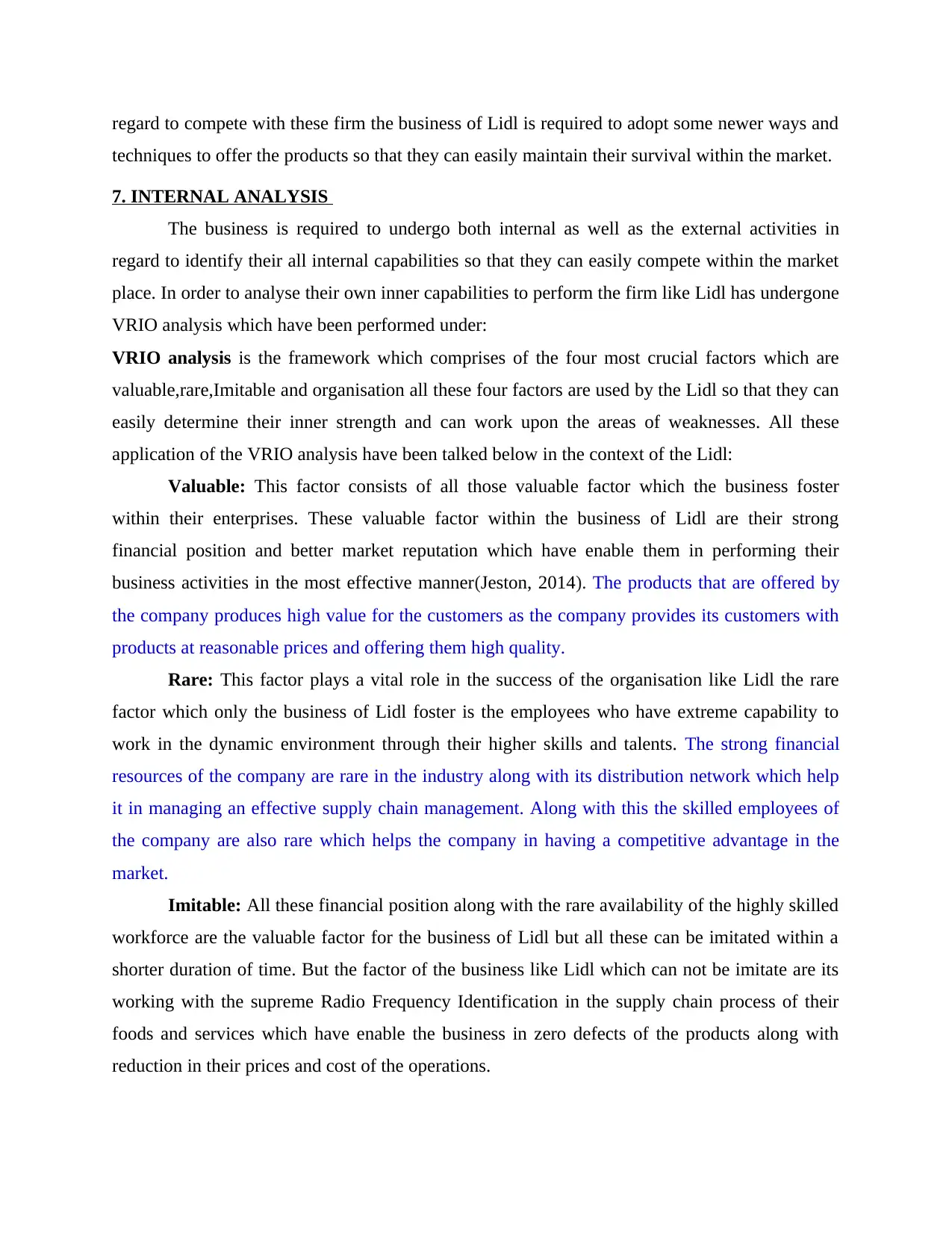
regard to compete with these firm the business of Lidl is required to adopt some newer ways and
techniques to offer the products so that they can easily maintain their survival within the market.
7. INTERNAL ANALYSIS
The business is required to undergo both internal as well as the external activities in
regard to identify their all internal capabilities so that they can easily compete within the market
place. In order to analyse their own inner capabilities to perform the firm like Lidl has undergone
VRIO analysis which have been performed under:
VRIO analysis is the framework which comprises of the four most crucial factors which are
valuable,rare,Imitable and organisation all these four factors are used by the Lidl so that they can
easily determine their inner strength and can work upon the areas of weaknesses. All these
application of the VRIO analysis have been talked below in the context of the Lidl:
Valuable: This factor consists of all those valuable factor which the business foster
within their enterprises. These valuable factor within the business of Lidl are their strong
financial position and better market reputation which have enable them in performing their
business activities in the most effective manner(Jeston, 2014). The products that are offered by
the company produces high value for the customers as the company provides its customers with
products at reasonable prices and offering them high quality.
Rare: This factor plays a vital role in the success of the organisation like Lidl the rare
factor which only the business of Lidl foster is the employees who have extreme capability to
work in the dynamic environment through their higher skills and talents. The strong financial
resources of the company are rare in the industry along with its distribution network which help
it in managing an effective supply chain management. Along with this the skilled employees of
the company are also rare which helps the company in having a competitive advantage in the
market.
Imitable: All these financial position along with the rare availability of the highly skilled
workforce are the valuable factor for the business of Lidl but all these can be imitated within a
shorter duration of time. But the factor of the business like Lidl which can not be imitate are its
working with the supreme Radio Frequency Identification in the supply chain process of their
foods and services which have enable the business in zero defects of the products along with
reduction in their prices and cost of the operations.
techniques to offer the products so that they can easily maintain their survival within the market.
7. INTERNAL ANALYSIS
The business is required to undergo both internal as well as the external activities in
regard to identify their all internal capabilities so that they can easily compete within the market
place. In order to analyse their own inner capabilities to perform the firm like Lidl has undergone
VRIO analysis which have been performed under:
VRIO analysis is the framework which comprises of the four most crucial factors which are
valuable,rare,Imitable and organisation all these four factors are used by the Lidl so that they can
easily determine their inner strength and can work upon the areas of weaknesses. All these
application of the VRIO analysis have been talked below in the context of the Lidl:
Valuable: This factor consists of all those valuable factor which the business foster
within their enterprises. These valuable factor within the business of Lidl are their strong
financial position and better market reputation which have enable them in performing their
business activities in the most effective manner(Jeston, 2014). The products that are offered by
the company produces high value for the customers as the company provides its customers with
products at reasonable prices and offering them high quality.
Rare: This factor plays a vital role in the success of the organisation like Lidl the rare
factor which only the business of Lidl foster is the employees who have extreme capability to
work in the dynamic environment through their higher skills and talents. The strong financial
resources of the company are rare in the industry along with its distribution network which help
it in managing an effective supply chain management. Along with this the skilled employees of
the company are also rare which helps the company in having a competitive advantage in the
market.
Imitable: All these financial position along with the rare availability of the highly skilled
workforce are the valuable factor for the business of Lidl but all these can be imitated within a
shorter duration of time. But the factor of the business like Lidl which can not be imitate are its
working with the supreme Radio Frequency Identification in the supply chain process of their
foods and services which have enable the business in zero defects of the products along with
reduction in their prices and cost of the operations.
⊘ This is a preview!⊘
Do you want full access?
Subscribe today to unlock all pages.

Trusted by 1+ million students worldwide
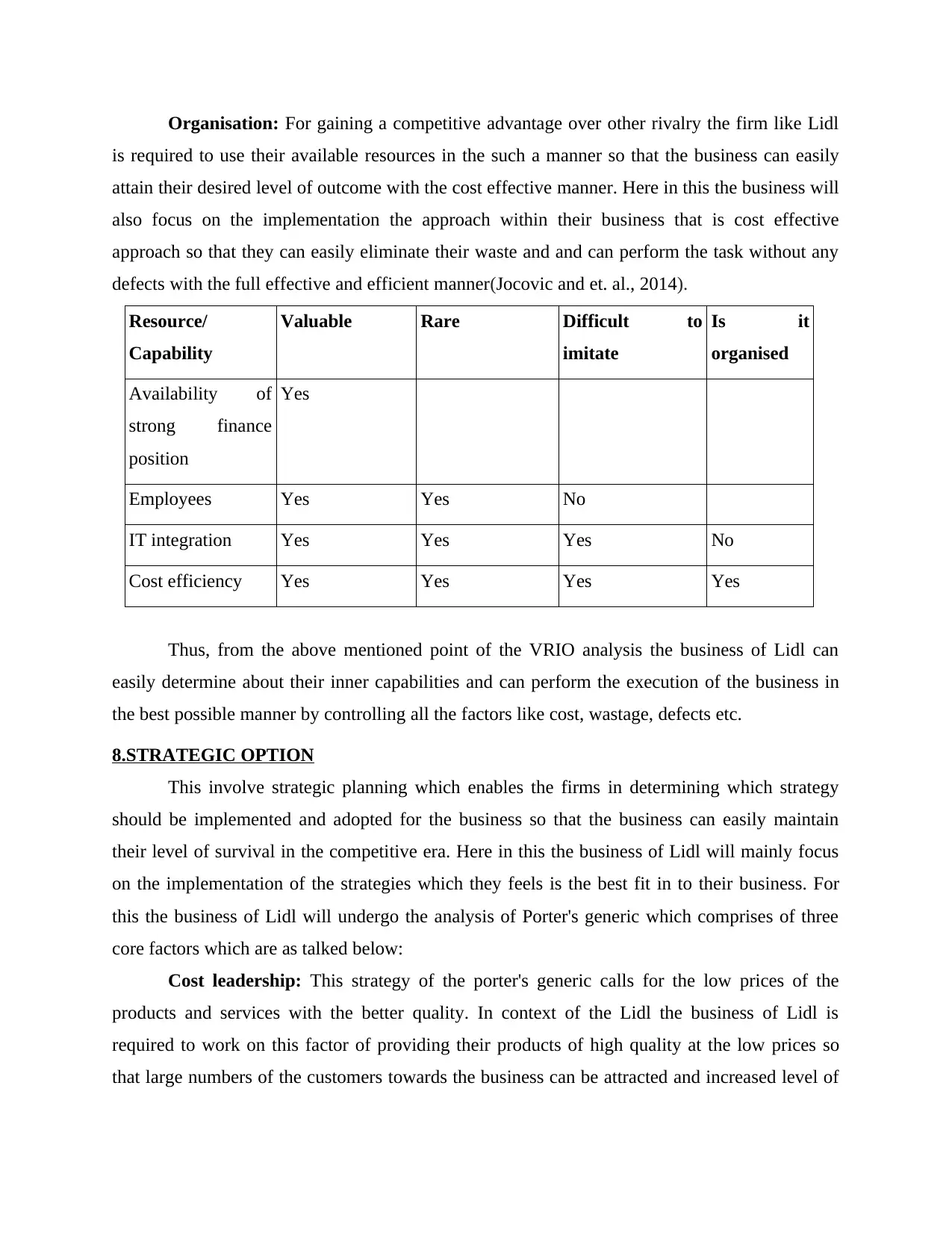
Organisation: For gaining a competitive advantage over other rivalry the firm like Lidl
is required to use their available resources in the such a manner so that the business can easily
attain their desired level of outcome with the cost effective manner. Here in this the business will
also focus on the implementation the approach within their business that is cost effective
approach so that they can easily eliminate their waste and and can perform the task without any
defects with the full effective and efficient manner(Jocovic and et. al., 2014).
Resource/
Capability
Valuable Rare Difficult to
imitate
Is it
organised
Availability of
strong finance
position
Yes
Employees Yes Yes No
IT integration Yes Yes Yes No
Cost efficiency Yes Yes Yes Yes
Thus, from the above mentioned point of the VRIO analysis the business of Lidl can
easily determine about their inner capabilities and can perform the execution of the business in
the best possible manner by controlling all the factors like cost, wastage, defects etc.
8.STRATEGIC OPTION
This involve strategic planning which enables the firms in determining which strategy
should be implemented and adopted for the business so that the business can easily maintain
their level of survival in the competitive era. Here in this the business of Lidl will mainly focus
on the implementation of the strategies which they feels is the best fit in to their business. For
this the business of Lidl will undergo the analysis of Porter's generic which comprises of three
core factors which are as talked below:
Cost leadership: This strategy of the porter's generic calls for the low prices of the
products and services with the better quality. In context of the Lidl the business of Lidl is
required to work on this factor of providing their products of high quality at the low prices so
that large numbers of the customers towards the business can be attracted and increased level of
is required to use their available resources in the such a manner so that the business can easily
attain their desired level of outcome with the cost effective manner. Here in this the business will
also focus on the implementation the approach within their business that is cost effective
approach so that they can easily eliminate their waste and and can perform the task without any
defects with the full effective and efficient manner(Jocovic and et. al., 2014).
Resource/
Capability
Valuable Rare Difficult to
imitate
Is it
organised
Availability of
strong finance
position
Yes
Employees Yes Yes No
IT integration Yes Yes Yes No
Cost efficiency Yes Yes Yes Yes
Thus, from the above mentioned point of the VRIO analysis the business of Lidl can
easily determine about their inner capabilities and can perform the execution of the business in
the best possible manner by controlling all the factors like cost, wastage, defects etc.
8.STRATEGIC OPTION
This involve strategic planning which enables the firms in determining which strategy
should be implemented and adopted for the business so that the business can easily maintain
their level of survival in the competitive era. Here in this the business of Lidl will mainly focus
on the implementation of the strategies which they feels is the best fit in to their business. For
this the business of Lidl will undergo the analysis of Porter's generic which comprises of three
core factors which are as talked below:
Cost leadership: This strategy of the porter's generic calls for the low prices of the
products and services with the better quality. In context of the Lidl the business of Lidl is
required to work on this factor of providing their products of high quality at the low prices so
that large numbers of the customers towards the business can be attracted and increased level of
Paraphrase This Document
Need a fresh take? Get an instant paraphrase of this document with our AI Paraphraser
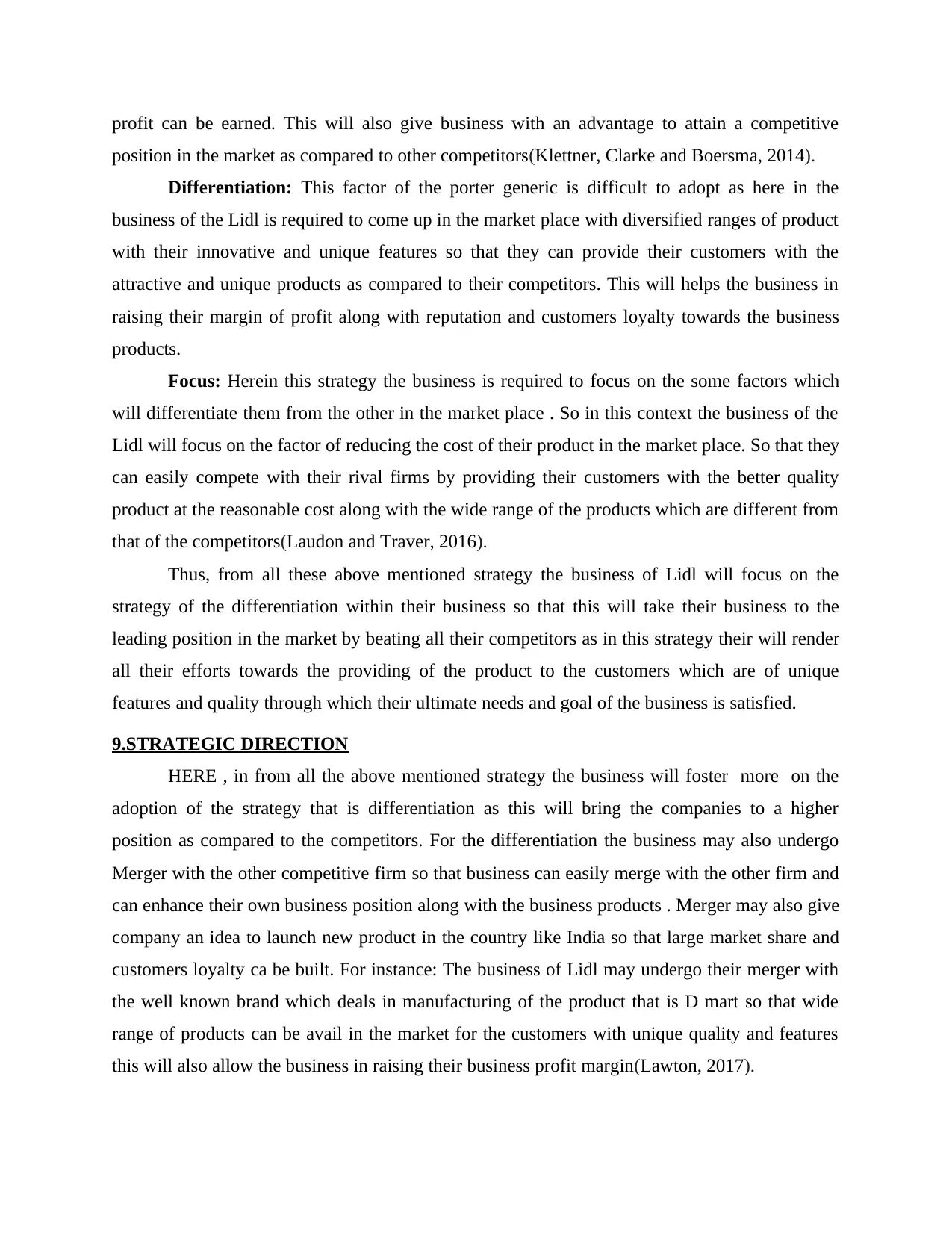
profit can be earned. This will also give business with an advantage to attain a competitive
position in the market as compared to other competitors(Klettner, Clarke and Boersma, 2014).
Differentiation: This factor of the porter generic is difficult to adopt as here in the
business of the Lidl is required to come up in the market place with diversified ranges of product
with their innovative and unique features so that they can provide their customers with the
attractive and unique products as compared to their competitors. This will helps the business in
raising their margin of profit along with reputation and customers loyalty towards the business
products.
Focus: Herein this strategy the business is required to focus on the some factors which
will differentiate them from the other in the market place . So in this context the business of the
Lidl will focus on the factor of reducing the cost of their product in the market place. So that they
can easily compete with their rival firms by providing their customers with the better quality
product at the reasonable cost along with the wide range of the products which are different from
that of the competitors(Laudon and Traver, 2016).
Thus, from all these above mentioned strategy the business of Lidl will focus on the
strategy of the differentiation within their business so that this will take their business to the
leading position in the market by beating all their competitors as in this strategy their will render
all their efforts towards the providing of the product to the customers which are of unique
features and quality through which their ultimate needs and goal of the business is satisfied.
9.STRATEGIC DIRECTION
HERE , in from all the above mentioned strategy the business will foster more on the
adoption of the strategy that is differentiation as this will bring the companies to a higher
position as compared to the competitors. For the differentiation the business may also undergo
Merger with the other competitive firm so that business can easily merge with the other firm and
can enhance their own business position along with the business products . Merger may also give
company an idea to launch new product in the country like India so that large market share and
customers loyalty ca be built. For instance: The business of Lidl may undergo their merger with
the well known brand which deals in manufacturing of the product that is D mart so that wide
range of products can be avail in the market for the customers with unique quality and features
this will also allow the business in raising their business profit margin(Lawton, 2017).
position in the market as compared to other competitors(Klettner, Clarke and Boersma, 2014).
Differentiation: This factor of the porter generic is difficult to adopt as here in the
business of the Lidl is required to come up in the market place with diversified ranges of product
with their innovative and unique features so that they can provide their customers with the
attractive and unique products as compared to their competitors. This will helps the business in
raising their margin of profit along with reputation and customers loyalty towards the business
products.
Focus: Herein this strategy the business is required to focus on the some factors which
will differentiate them from the other in the market place . So in this context the business of the
Lidl will focus on the factor of reducing the cost of their product in the market place. So that they
can easily compete with their rival firms by providing their customers with the better quality
product at the reasonable cost along with the wide range of the products which are different from
that of the competitors(Laudon and Traver, 2016).
Thus, from all these above mentioned strategy the business of Lidl will focus on the
strategy of the differentiation within their business so that this will take their business to the
leading position in the market by beating all their competitors as in this strategy their will render
all their efforts towards the providing of the product to the customers which are of unique
features and quality through which their ultimate needs and goal of the business is satisfied.
9.STRATEGIC DIRECTION
HERE , in from all the above mentioned strategy the business will foster more on the
adoption of the strategy that is differentiation as this will bring the companies to a higher
position as compared to the competitors. For the differentiation the business may also undergo
Merger with the other competitive firm so that business can easily merge with the other firm and
can enhance their own business position along with the business products . Merger may also give
company an idea to launch new product in the country like India so that large market share and
customers loyalty ca be built. For instance: The business of Lidl may undergo their merger with
the well known brand which deals in manufacturing of the product that is D mart so that wide
range of products can be avail in the market for the customers with unique quality and features
this will also allow the business in raising their business profit margin(Lawton, 2017).

The company can expand its business strategically in the Indian markets by the following
ways: Acquisition : In this method the company acquires more than 50% of stake in other
company which results in the transfer of ownership of the acquired company in the hands
of the acquiring company. This method can be used by Lidl to expand its business in
India and will help the company to take the advantage of already existing market base of
the company that is acquired.
Franchising: It is a method in which company gives license of using its methods of
preparation of goods and services along with the use of its logistics, brand name, business
model etc. to other company. Lidl can use this method by giving the license to some other
company in India which will work on the behalf of Lidl.
Online sales: Lidl can also expand its business in other market by the way of online
sales by which the customers of India can order the products from the online portal and
the ordered items can be shipped in time so as to be available to the Indian customers.
10.CONCLUSION
From the above inferred report it can be summarised that strategic management within
the business plays a vital role as this enables the business to look and evaluate all the tactics so
that better strategy for the business can be chosen and through that chosen strategy business can
easily come up with the better results. Formulation of the effective strategy is done only after the
evaluation of all the external and internal factors through Pestle and VRIO analysis. So that
better strategies for the business can be chosen and effective in the level of performance can be
maintained.
ways: Acquisition : In this method the company acquires more than 50% of stake in other
company which results in the transfer of ownership of the acquired company in the hands
of the acquiring company. This method can be used by Lidl to expand its business in
India and will help the company to take the advantage of already existing market base of
the company that is acquired.
Franchising: It is a method in which company gives license of using its methods of
preparation of goods and services along with the use of its logistics, brand name, business
model etc. to other company. Lidl can use this method by giving the license to some other
company in India which will work on the behalf of Lidl.
Online sales: Lidl can also expand its business in other market by the way of online
sales by which the customers of India can order the products from the online portal and
the ordered items can be shipped in time so as to be available to the Indian customers.
10.CONCLUSION
From the above inferred report it can be summarised that strategic management within
the business plays a vital role as this enables the business to look and evaluate all the tactics so
that better strategy for the business can be chosen and through that chosen strategy business can
easily come up with the better results. Formulation of the effective strategy is done only after the
evaluation of all the external and internal factors through Pestle and VRIO analysis. So that
better strategies for the business can be chosen and effective in the level of performance can be
maintained.
⊘ This is a preview!⊘
Do you want full access?
Subscribe today to unlock all pages.

Trusted by 1+ million students worldwide
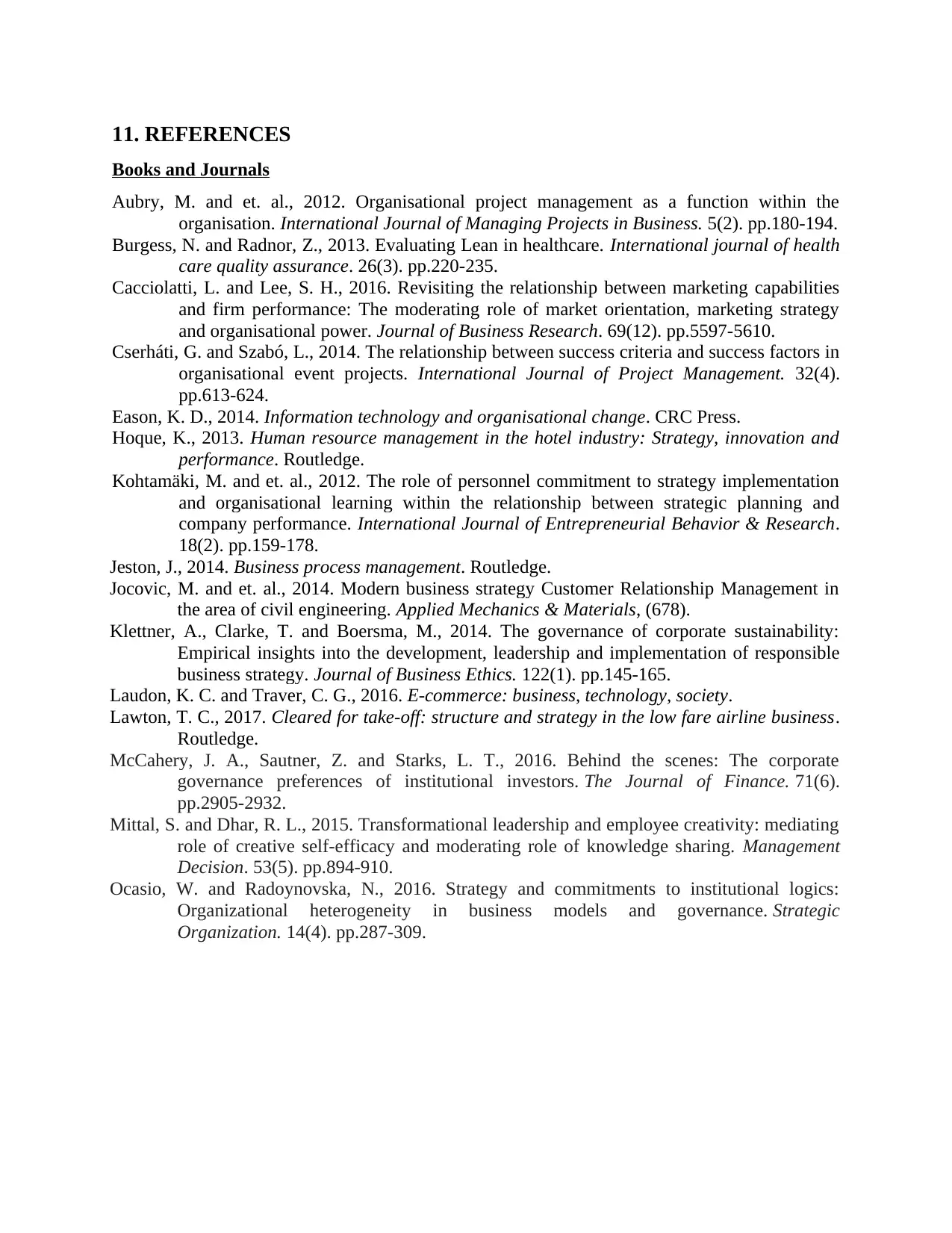
11. REFERENCES
Books and Journals
Aubry, M. and et. al., 2012. Organisational project management as a function within the
organisation. International Journal of Managing Projects in Business. 5(2). pp.180-194.
Burgess, N. and Radnor, Z., 2013. Evaluating Lean in healthcare. International journal of health
care quality assurance. 26(3). pp.220-235.
Cacciolatti, L. and Lee, S. H., 2016. Revisiting the relationship between marketing capabilities
and firm performance: The moderating role of market orientation, marketing strategy
and organisational power. Journal of Business Research. 69(12). pp.5597-5610.
Cserháti, G. and Szabó, L., 2014. The relationship between success criteria and success factors in
organisational event projects. International Journal of Project Management. 32(4).
pp.613-624.
Eason, K. D., 2014. Information technology and organisational change. CRC Press.
Hoque, K., 2013. Human resource management in the hotel industry: Strategy, innovation and
performance. Routledge.
Kohtamäki, M. and et. al., 2012. The role of personnel commitment to strategy implementation
and organisational learning within the relationship between strategic planning and
company performance. International Journal of Entrepreneurial Behavior & Research.
18(2). pp.159-178.
Jeston, J., 2014. Business process management. Routledge.
Jocovic, M. and et. al., 2014. Modern business strategy Customer Relationship Management in
the area of civil engineering. Applied Mechanics & Materials, (678).
Klettner, A., Clarke, T. and Boersma, M., 2014. The governance of corporate sustainability:
Empirical insights into the development, leadership and implementation of responsible
business strategy. Journal of Business Ethics. 122(1). pp.145-165.
Laudon, K. C. and Traver, C. G., 2016. E-commerce: business, technology, society.
Lawton, T. C., 2017. Cleared for take-off: structure and strategy in the low fare airline business.
Routledge.
McCahery, J. A., Sautner, Z. and Starks, L. T., 2016. Behind the scenes: The corporate
governance preferences of institutional investors. The Journal of Finance. 71(6).
pp.2905-2932.
Mittal, S. and Dhar, R. L., 2015. Transformational leadership and employee creativity: mediating
role of creative self-efficacy and moderating role of knowledge sharing. Management
Decision. 53(5). pp.894-910.
Ocasio, W. and Radoynovska, N., 2016. Strategy and commitments to institutional logics:
Organizational heterogeneity in business models and governance. Strategic
Organization. 14(4). pp.287-309.
Books and Journals
Aubry, M. and et. al., 2012. Organisational project management as a function within the
organisation. International Journal of Managing Projects in Business. 5(2). pp.180-194.
Burgess, N. and Radnor, Z., 2013. Evaluating Lean in healthcare. International journal of health
care quality assurance. 26(3). pp.220-235.
Cacciolatti, L. and Lee, S. H., 2016. Revisiting the relationship between marketing capabilities
and firm performance: The moderating role of market orientation, marketing strategy
and organisational power. Journal of Business Research. 69(12). pp.5597-5610.
Cserháti, G. and Szabó, L., 2014. The relationship between success criteria and success factors in
organisational event projects. International Journal of Project Management. 32(4).
pp.613-624.
Eason, K. D., 2014. Information technology and organisational change. CRC Press.
Hoque, K., 2013. Human resource management in the hotel industry: Strategy, innovation and
performance. Routledge.
Kohtamäki, M. and et. al., 2012. The role of personnel commitment to strategy implementation
and organisational learning within the relationship between strategic planning and
company performance. International Journal of Entrepreneurial Behavior & Research.
18(2). pp.159-178.
Jeston, J., 2014. Business process management. Routledge.
Jocovic, M. and et. al., 2014. Modern business strategy Customer Relationship Management in
the area of civil engineering. Applied Mechanics & Materials, (678).
Klettner, A., Clarke, T. and Boersma, M., 2014. The governance of corporate sustainability:
Empirical insights into the development, leadership and implementation of responsible
business strategy. Journal of Business Ethics. 122(1). pp.145-165.
Laudon, K. C. and Traver, C. G., 2016. E-commerce: business, technology, society.
Lawton, T. C., 2017. Cleared for take-off: structure and strategy in the low fare airline business.
Routledge.
McCahery, J. A., Sautner, Z. and Starks, L. T., 2016. Behind the scenes: The corporate
governance preferences of institutional investors. The Journal of Finance. 71(6).
pp.2905-2932.
Mittal, S. and Dhar, R. L., 2015. Transformational leadership and employee creativity: mediating
role of creative self-efficacy and moderating role of knowledge sharing. Management
Decision. 53(5). pp.894-910.
Ocasio, W. and Radoynovska, N., 2016. Strategy and commitments to institutional logics:
Organizational heterogeneity in business models and governance. Strategic
Organization. 14(4). pp.287-309.
1 out of 13
Related Documents
Your All-in-One AI-Powered Toolkit for Academic Success.
+13062052269
info@desklib.com
Available 24*7 on WhatsApp / Email
![[object Object]](/_next/static/media/star-bottom.7253800d.svg)
Unlock your academic potential
© 2024 | Zucol Services PVT LTD | All rights reserved.





